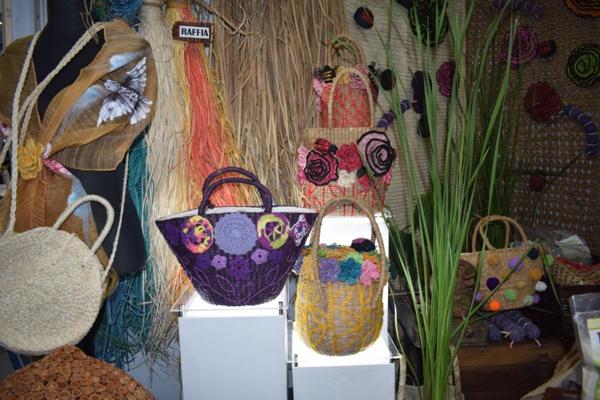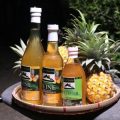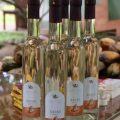From the plain-looking handwoven slippers to embroidered bags and embellished baskets, the seagrass craft making in San Fernando, Camarines Sur has upscaled into a full-blown home-based business industry enterprise providing additional income to rice farmers in the flood-prone areas.

According to the Department of Agriculture-Regional Field Office (DA-RFO) 5-Bicol Integrated Agricultural Research Center (BIARC), the majority of the flood-prone rice producing areas were left fallowed thus additional costs on herbicides and labor are needed to remove various weeds and sedges that emerge after the fallow period. “In the project site, while many people use various weed species as forage for animals, ingenious farmers surprisingly explored promising potential uses of seagrass,” shared BIARC Manager Luz R. Marcelino. This shed light on the seagrass craft making, a promising income-generating opportunity for the farmers.
The project that started it all
Seagrass (Rynchospora corymbosa), locally-known as ragiwdiw and bankuan, is a perennial sedge that grows abundantly in flood-prone areas in Bicol. Dried stalks from seagrass are hand twined together to create the raw material for handicraft making—salapid. The salapid can be made into various products such as bags, slippers, hampers, and decorative items. According to Marcelino, the best characteristic of seagrass is its resistance to molds when stored for a longer period of time.
Thus, to further develop the seagrass enterprise, BIARC implemented the project, “Enterprise Development in Flood Prone Areas in Camarines Sur.” Funded by the Philippine Rice Research Institute (PhilRice) and the Bureau of Agricultural Research (BAR), the project aimed to provide opportunities for rural employment, increase family income and empower communities through the development of agri-business enterprise. The goals of the project were to: 1) develop rice-based production systems within the framework of integrated farming systems approach; 2) identify researchable areas for optimized seagrass-based enterprise development; and, 3) develop a village-level handicraft production enterprise.
“Ang masasabi ko lang po sa Bikolano farmers, they are very, very resourceful. They tied up with Department of Trade and Industry (DTI) para magkaroon ng enhancement doon sa product nila,” according to Marcelino, project proponent. In coordination with DTI-Product Development and Design Center of the Philippines, farmer cooperators’ association were provided with skill and product development training and sponsored their participation in national trade fairs.
To support the associations’ full operation to meet the increasing demand of seagrass in the local handicraft industry, BAR extended institutional support through the provision of common service facilities and production equipment.
Marcelino also proudly shared, “[n]agpapasalamat din po ako sa mga San Fernando farmers because they were really innovative. They were really bent on improving their lives in terms of the resources of what [are] the resources na nandoon sa kanila.”

From simple products to elite fashion items
After the project has ended, BIARC continued their efforts in upscaling and expanding the seagrass craft industry in Camarines Sur. They tapped the creativity and entrepreneurial skills of Bernadette B. De Los Santos, owner of Bidibidi Enterprise, a social enterprise that combines fashion, arts and upcycling while providing livelihood to local women and out-of-school youth in Baao, Camarines Sur.
De Los Santos is part of the Gender Responsive Economic Actions for the Transformation of Women (GREAT Women) project, a Philippine-Canadian brainchild that aimed to provide support for women to start businesses and obtain a better-paying job. This project is handled by DTI together with the Department of Science and Technology, DA, Bureau of Fisheries and Aquatic Resources, Department of Labor and Employment, Philippine Commission on Women, small and medium enterprises, and private sector representatives.
She shared, “I started hand embroidery on fabrics. But they were the ones who told me, ‘why don’t you try seagrass as baskets and bags, and use your art sa pag-e-embellish?” With BIARC (as it was scouting for area for expansion) suggestion, she started making bags and baskets using seagrass as a raw material and embellished them using other natural fibers such as raffia and abaca in 2017. The following year, DTI invited her to showcase her products at the Manila FAME, a biannual lifestyle and design trade show that aims to promote the Philippines as a reliable sourcing destination for high-quality home, fashion, holiday, architectural and interior pieces. Then, she participated in ArteFino Fair, the biggest artisan fair in the country. She proudly shared, “ako ang favorite, ang sales ko is more than half a million,” during the four-day event.
With the growing interest in sustainable fashion items, bags made from natural fibers such as seagrass would surely be a hit. In fact, she shared, “patok na patok iyan ngayon kasi may consciousness na ang mga tao, gusto nila good for the environment—fashionable ka na, good for the environment pa ang sinusuot mo.”
After her participation at the ArteFino Fair, she has received invitations for interviews from various television networks to which she reacted, “I think it’s kinda phenomenal na from a mere grass, now it’s a high-end product; although it’s not original kasi marami namang gumawa ng baskets.”
An elite shopping center and Filipino culture shop have also shown interest in her products. She shared, “[a]ng sabi nga nila sa akin, akmang-akma itong paggawa ko kasi pukaw na ang Pilipino ngayon. They are starting to take pride in what they have.”
Her products have also garnered attention from personalities across the globe. Fashion icons such as actress Heart Evangelista, Miss Universe 2015 Pia Wurtzbach, and international fashion designer Christian Louboutin have taken an interest with her world-class design and handicraft.
To keep up with the ever-changing landscape of the fashion industry, De Los Santos consulted BIARC on other natural fibers that can be used as raw materials for her products. She explained, “sa aking ginagawa ang naitulong talaga [ng research] is iyong kapag naghahanap ako ng ibang fiber. Sila naman ang kinokontak ko. Kasi gusto kong mag-infuse [ng ibang fiber]. We are into saluyot para i-incorporate namin. Kasi sa fashion mabilis silang magsawa, so kailangan mayroon kang bagong idea.”
The women behind this success
Before venturing into the handicraft industry, De Los Santos was a farmer. She said, “nagsimula ako as a farmer dito sa Baao, but of course, I have always been an artist ” In fact, she was awarded as the Most Outstanding Rural Woman in 2008.
“Naisip ko lang to go to crafts because I observed na ang mga asawa ng farmers from the time they plant until the time they harvest walang ginagawa. So iyon ang naging trabaho ko rito sa amin, tinuruan ko [silang] magburda, ng kung anu-anong mga ginawa,” she shared.
She has been teaching women the necessary skills to make the bags such as basket weaving, embroidery, and crocheting. National agencies such as DA, DTI, and Department of Social Welfare and Development has tapped her to train more communities outside Baao. She explained, “nagturo kami via DA, nagturo kami sa mga nasalanta ng Mayon Volcano eruption. So may mga weavers kami sa Albay, lahat ng kailangan kong skill tinuturo namin. Para after ng training sa kanila na kami kukuha, mayroon kaagad silang income.”
“[My] goal is to empower these women by teaching them the skills and bring about the best in them, while allowing them to be mothers, wives, sisters, nurturing their families, their communities,” De Los Santos shared in her social media account.
At the bottom of this success, what matters most for De Los Santos is the number of lives she has touched. “This is a social enterprise. Ang gusto ko mas maraming makakagamit; kasi pag marami, marami rin ang magagawa nila. Ang profit margin is very minimal but it’s enough to keep the business going, so that’s fine,” ended De Los Santos. ###
by Rena S. Hermoso, https://www.bar.gov.ph
————
For more information, please contact:
Luz R. Marcelino
Manager/Project Leader
BIARC, DA-RFO 5
Pili, Camarines Sur
Phone: (054) 477 0475
Email: luzmarcelino@yahoo.com







